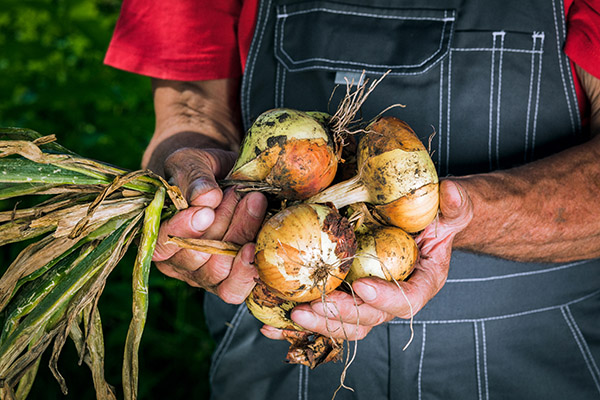This is the second installment of our series on sustainable farming practices, where we take a closer look at how each practice can bring long-term economic and environmental benefits.
Farmers who are interested in pursuing organics have good reason. The USDA says consumer demand for organically produced goods shows double-digit growth, while the Organic Trade Association’s most recent industry survey found organic sales in the food and non-food markets reached a record $55.1 billion.
Higher demand results in higher price premiums, which are a key part of what makes organic farming a sustainable practice.
As we explained in the first article of our sustainable farming series, a sustainable practice is considered such when it is productive and profitable, while enhancing both the quality of the environment and the lives of the producer and society as a whole. Organic farming can meet all of these.
What is Organic Farming?
First, let’s define organic farming. The USDA says organic is a labeling term that indicates food or agricultural product were produced through approved methods. These methods use natural processes and materials to support cycling of on-farm resources, promote ecological balance and conserve biodiversity. Genetically engineered crops, synthetic fertilizers and chemical pesticides are examples of practices generally not permitted under organic.
Benefits of Organic Farming
Because of the stricter production practices, in combination with high consumer demand, organic farmers and ranchers earn a premium for their products. It is why one of the key benefits of organic farming is profitability.
When using 2014-2018 FINBIN data, a national database of actual farm data, Purdue University ag economists found a rotation of organic corn, soybeans and wheat resulted in a $268-per-acre net return to land — approximately $110 and $120 higher than conventional corn-soybean and corn-soybean-wheat rotations, respectively.
These profits happened despite lower yields. In fact, the same FINBIN data showed organic corn, soybean, and wheat yields were 32%, 33% and 24% less than their conventional counterparts, respectively.
Lower yields are often a criticism of organic farming’s sustainability. But organic yields can be competitive to conventional, and under some circumstances, even better.
The Rodale Institute has conducted side-by-side research plots of organic and conventional grain cropping systems since 1981. In the first three decades of their trials, they found organic corn and soybean yields were equivalent to yields of conventional crops grown under tillage-based systems. In fact, in times of drought, organic corn yields were actually 31% higher.
This is due to the soil health benefits of organic farming — even though organic relies on tillage for weed control, another criticism of its ability to be sustainable. Because of how tillage disrupts the soil, the NRCS says it increases the odds of erosion, soil compaction, reduced water infiltration and the release of carbon dioxide.
But other practices used in organic farming, such as cover cropping, diversified crop rotations and manure application, help build soil health; and data from Rodale’s trials show soil organic matter continuously increases in organic systems.
Organic farming also contributes to better environmental outcomes. The absence of synthetic fertilizers and pesticides reduces groundwater pollution, while many management practices increase soil carbon, which helps mitigate against climate change, says the Food and Agriculture Organization of the United Nations.
In addition to improving the soil health, organic is perceived to be better for human health, and research backs that up. A meta-analysis conducted by researchers at Newcastle University found organic crops have 18-69% higher concentration of antioxidant compounds. If consumers switch to organic, the researchers conclude they would consume 20-40% more antioxidants — equivalent to two extra portions of fruits and vegetables. The study also found pesticide residues are 3-4 times more likely in conventional food vs. organic.
How to Become an Organic Farmer or Rancher
Farmers can’t become ‘organic’ overnight. The USDA requires land for raw organic commodities go through a 36-month transition period in which no prohibited substances are applied before receiving certification. During this time, farmers will need to document all land use and material application.
The same applies to land used for grazing livestock. If a dairy or poultry farm wants to produce organic products like eggs or milk, the animals can only consume organic feed, which is ideally grown on the farm. Ruminant livestock are required to graze organic pasture.
Once the transition period has been completed, farmers can apply for organic certification. A USDA-authorized certifier will review the application and conduct an on-site inspection. If the farm is compliant with organic regulations, the farmer will receive their certificate and can begin marketing their products as organic.
What’s the Investment?
The cost of becoming certified organic depends on the size, type and complexity of the farm, as well as the certifier, but the USDA says it can range from a few hundred dollars to several thousands. Expect to pay an application fee, annual renewal fee, assessment on annual production or sales, and inspection fees.
Crop producers may also need to invest in additional equipment, such as weed flamers or tine weeders, for weed control. Additionally, plan to work with a financial advisor and ag lender to ensure continuity of operating funds through the conversion period.
Conterra Ag lends exclusively to American agriculture and has expertise in a variety of farm and ranch operations utilizing both traditional and sustainable farming practices. If you’re ready to refinance, or looking to grow your operation, let’s talk ag – contact your Conterra relationship manager today.


